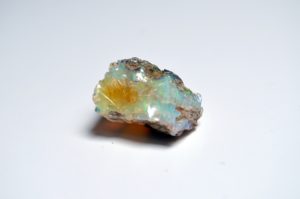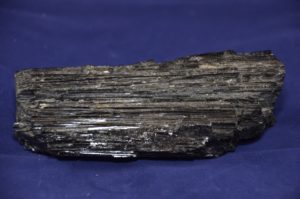Opals ought to come with a warning that only the October-born, or those born under the zodiac sign Scorpio, should wear them. Most gemstones grow in geometrical and organized crystal form, but opal is not a crystal; it’s more of a solidified jelly. The jelly can be white, rose, blue, or black, and the rainbow colors trapped and flashing within the stone, giving the illusion of depth, are unique to each opal.
The problem with opals is that those fascinating aurora-borealis flashes come from a chaotic internal structure. The October-born, and the Scorpios born in October or November, can wear opal without inviting chaos into their lives. Others should wear it only when wanting some excitement, and take it off when the drama exceeds their tolerance.

Each color of opal has a different name. The rose-pink opal, for example, is called the Cupid opal, and the black opals are called “Australian” because the very best of them, with neon-colored flashes, are mined in Australian deserts. The “Denver opal,” not a true opal, is brown with opalescent rivers running through it. The Mexican fire opal is root-beer brown with strong green, orange, and yellow flashes, and a favorite in men’s rings, especially in the American Southwest. Distinguish this from “Mexican opal,” which is solid orange and translucent like a gel, and more vivid than carnelian. It’s a favorite of those who like orange stones.
Opals are a challenge to own and wear. They can be utterly destroyed by heat, cleaning or a blow. Soft and porous, rating about 5.5 in hardness on a scale of 10, opals are therefore a poor choice for rings. Opals should be stored in water because they are “hydrous” and if treated like other gems will dry out and crack. A genuine opal will stick to your tongue. Most opals on the market are synthetic, and you will know this because they are set in silver, are bright aqua blue or baby pink, freckled with colors like glitter which are visible from all angles, and cheap. Milky shades are supposed to be soothing, but no opal is soothing. When you look into an opal you aren’t relaxing; you are seeking something in its depths.
Opals and Luck
The authoritative New Age book Healing with Crystals and Gemstones says opals absorb negativity, and warns against wearing them with other stones. They certainly command attention. Wearers should be prepared to handle the remarks—because everyone has something to say about opals—and the envy.
Opals have been blamed for plague. There are scores of stories of bad luck for opal wearers including Napoleon’s Josephine (born in June) whom he left high and dry, and Alfonso XII of Spain. He gave an opal to his mistresses who then became ill, one after another. (Probably Alfonso gave them something more than opals.) Finally his Queen laid the unlucky opal around the neck of a statue of the Virgin Mary.
The Magic and Science of Jewels and Stones, Vol. II, devotes 15 pages to the opal’s lore and powers. Because opal contains the colors of every other precious stone, and all of the good traits of those stones, opal is a kind of super-stone. It’s rumored, but not proven, that wearers are immune to lightning strikes.That book also says it can make Leo, Libra, and Aquarius women beautiful, so if you are an October-born Libra female, wearing your birthstone will generate twice the benefit.
Cunningham’s Encyclopedia of Crystal, Gem and Metal Magic says opal is connected with all planets, and its powers include astral projection, protection for the body and spirit during astral projection, psychic power, good luck, and the ability to become invisible—if you carry your opal in a fresh bay leaf. To develop psychic power, wear opals as earrings. They are also said to bring out inner beauty. Wiccans and practitioners of New Age “magick” wear black opals.
The Alternative: Tourmaline
Natural opals and the alternative birthstone, tourmalines, are expensive gems, but comparable in price. Genuine tourmaline is a hard, hexagonal crystal celebrated for its neon colors and electrical capacity. If heated or rubbed, a tourmaline crystal can actually become a magnet, with positive and negative poles. There is no question that ancient people knew this and used it accordingly, and large tourmaline crystals are still used as wands.
Tourmalines for jewelry can be any color, including black or a very handsome brown, but the most popular in jewelry are pink, green, and blue-green, and there’s a bi-colored version called “watermelon tourmaline,” a green crystal with pink crystal inside. Wear a slice of this unique “watermelon” gem to balance your yin and yang. You will most likely find this novelty gem not at a jewelry store but at a gem and mineral show. Green is serene and attracts money and creativity, and pink is high-energy; wear pink tourmaline to be noticed or sociable, or for a mother-child bond.

Some birthstone guides specify that the October birthstone, specifically for October-born Librans, is the blue tourmaline, also called “indicolite.” Healing with Crystals and Gemstones by Daya Sarai Cochron says your inner guidance will help choose the color that is right for you.
Astrological authorities also differ on the planet that rules tourmaline, most often claiming it is either Jupiter or Saturn, but the confusion arose because each color is ruled by a different planet. Here is the latest regarding tourmaline’s planetary rulerships:
- Pink: Venus
- Red: Mars
- Green: Venus or Jupiter
- Blue: Venus
- Black: Saturn
Simulated opals and simulated tourmalines (often cubic zirconia of a pink tourmaline color) have no metaphysical powers.
